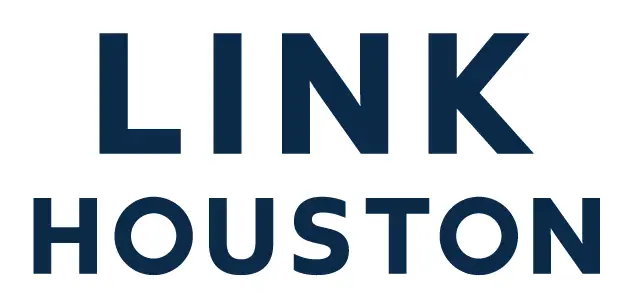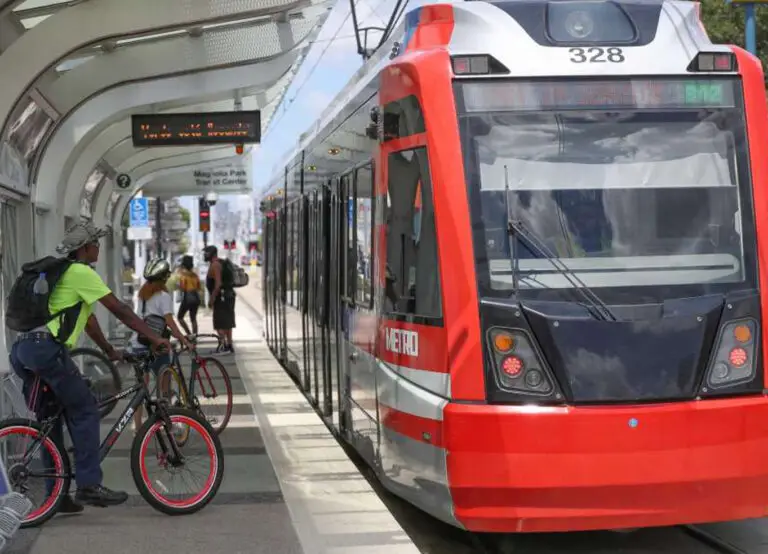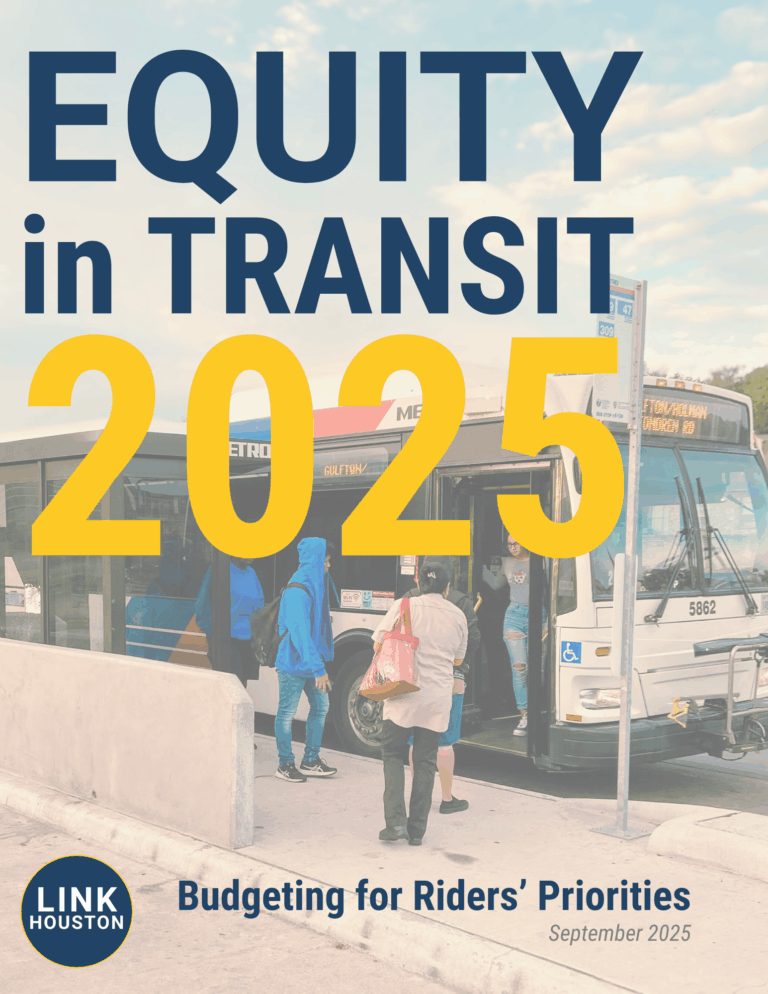The Harris County Metropolitan Transit Authority (METRO) Board now seems ready to move ahead with public engagement on a single METRONext plan to improve the public transit network across the Houston area. The region will likely reach nearly 10 million people by 2040 – a 50 percent increase in population. Overall, the METRONext plan reflects the upgrades community members requested: faster, reliable transit that moves people between jobs, centers of activity, and most important, homes, which are spread out across the region. We took a closer look at the latest version of METRONext, an estimated investment of about $3.3 billion to the regional transit network, to understand how the plan will advance geographical and economic access to opportunity.
System-wide Improvements
Topping the list are system-wide changes to improve the experience for every rider. First, METRO’s commitment to implementing universal accessibility by modifying streets, sidewalks, and bus stops will make it easier to approach and board the bus regardless of whether you’re using a wheelchair, a grandparent meeting up with friends, a child on the way to school, or simply weighed down by grocery bags. Second, new and renovated bus shelters, as well as investments in sidewalks, bikeways, and parking amenities at larger facilities, will improve the safety, comfort, and ease of connecting to and from transit.
Local Bus, Boost, and Bus Rapid Transit
Building on METRO’s 2015 reimagining that led to the New Bus Network, METRONext outlines meaningful enhancements and additions to bus transit: local bus, community connectors, Bus Operations Optimized System Treatments (BOOST) corridors, and bus rapid transit (BRT).
The plan will improve local bus services by extending hours for earlier mornings and later nights, a necessary change that should be distributed on major routes across the city to improve the utility of the network for riders (especially for workers with early or late shifts).
Four new community connectors would offer stops at important neighborhood destinations like grocery stores, community centers, and the post office. The community connectors in Eastex/Jensen and Little York/Homestead-Trinity/Houston Gardens are particularly important to keep in the plan, especially given that these communities have vocalized their need for better transit service. Gulfton is another good candidate for a community connector given the low car ownership rates and the resulting high number of people who use options other than a car to reach non-work destinations. (According to a Kinder Institute of Urban Research study, nearly half of Gulfton residents do non-work trips without a car.)
The BOOST Network, a re-branded version of METRO’s high frequency bus network, will establish a much-needed arrangement of 10 cross-city corridors with buses coming at frequent intervals, seven days a week in both north-south and east-west directions. Every proposed BOOST route will be an important link between communities and opportunity. The BOOST routes running east-west in southwest Houston, north-south in Greenspoint, east-west along Tidwell/Fulton and Longpoint, and north-south to Hobby Airport will be particularly useful in connecting communities to economic and education centers.
METRONext includes more BRT, adding to the single BRT line under construction in Uptown. In short, BRT uses high capacity buses running on dedicated infrastructure to pick up riders at platform stations and transports them quickly and reliably along a travel corridor. METRONext’s BRT extension from Uptown down to Gulfton is particularly important to implement, as it will connect the city’s most densely populated neighborhood to several major economic centers via fast and reliable transit. Similarly, the proposed University BRT line from Westchase to Kashmere Gardens via the Texas Southern University/ University of Houston area would significantly improve access to opportunity via public transit across a wide swath of the region, including East Houston. The University BRT line is a must-have to improve the backbone network of interrelated transit services supporting residents’ affordable access to economic opportunity. Increased transit services within and to Gulfton and North Houston underscore the importance to prioritize the creation of the proposed Gulfton and Tidwell/Fulton Transit Centers. The proposed BRT connector between Northwest Transit Center and downtown Houston will improve the utility and reliability of all bus services traveling the IH-10 Katy Freeway and US 290 corridors (including regional express park-and-ride services) and can be extended to connect to the Northwest Mall – the planned location for the high-speed rail station.
Light Rail and Regional Express Service Improvements
Twelve new miles of light rail will extend service to Hobby Airport via the Red and Purple Lines and extend the Red Line north to a new Tidwell/Fulton Transit Center. Connecting Hobby Airport with fast, reliable, and higher capacity transit, regardless of the exact mode, will improve residents’ access to economic opportunity and provide visitors the option to access the region by means other than a car (both important goals for Houston’s future success). Additionally, METRONext provides funds to enable the agency to spur regional partnerships to improve regional express routes (formerly park-and-ride) to connect more suburban residents to economic and education centers, potentially on a network of two-way HOV lanes created by partner agencies.
Conclusion: Hold Firm to Elements that Improve Equitable Outcomes Long-term
Overall, what LINK Houston likes about the plan is METRO’s aim to pursue more geographically and economically equitable access to opportunity by improving both transit service quality and quantity in the southwest, east, and northeast areas of the METRO service area. The investments in the local bus network, where METRO currently finds 67 percent of its ridership, are particularly important to implement in the final version of METRONext. Additionally, we want to see the universal accessibility element, the BOOST Network, BRT extension to Gulfton, the University BRT line, community connectors in North and Northeast Houston, and new transit centers in Gulfton and Tidwell/Fulton funded and constructed with priority. These specific projects will significantly improve the transit network to the benefit of much of the region and fuel modest economic growth by connecting people to opportunity, most especially in historically under-resourced communities.
LINK Houston sees four additional ways to improve the transit network and service quality. First, we would like to see METRONext expand early morning and late-night service hours on local bus and move as near as feasible to 24/7 service on existing and future rail, BRT, and BOOST services. Second, a transit center at Greenspoint makes sense given existing ridership, route transfers, one of the lowest car ownership rates in Houston, and the proposed transit service enhancements already prioritized in METRONext. Third, enhanced signage and wayfinding at principal stations and stops will increase service utility, improve first-time user experience, and encourage safe first and last mile access (e.g., transfer opportunities, bikeways & bike amenities, accessible walking routes to destinations within a half-mile radius). Fourth, METRO can transform existing transit centers and park-and-ride lots into more inviting multi-modal hubs to promote transit ridership (i.e., walk-and-ride, bike-and-ride, kiss-and-ride, park-and-ride, transfers) and alternative travel (i.e., carpool, vanpool, slugging, ride sourcing, etc.). Comparable facility improvements should be instituted systematically at all transit centers, as applicable to each site. Surplus property or space could be adapted to a complementary use or to provide additional amenities (i.e., food/beverage kiosks).
The present draft of METRONext recognizes that with limited means it is necessary to prioritize system improvements where they will have the most efficient and effective positive impact long-term. The proposed slate of improvements is only about 1/10th of the full METRO vision for what transit mobility should, or could, provide in the Houston region. The agency is limited by funding and will need in-kind and fiscal partnerships to pursue more of the vision. METRO will take their draft METRONext plan to the public in a variety of meetings in the coming months.
LINK Houston will continue to engage in this process by advocating for a robust, equitable, and multi-modal transportation network so that all people can reach opportunity in Houston. We invite you to consider how transit can be better for you, your family, your neighbors, and our growing region. We encourage you to participate in a METRONext public engagement session, which METRO will announce soon.





